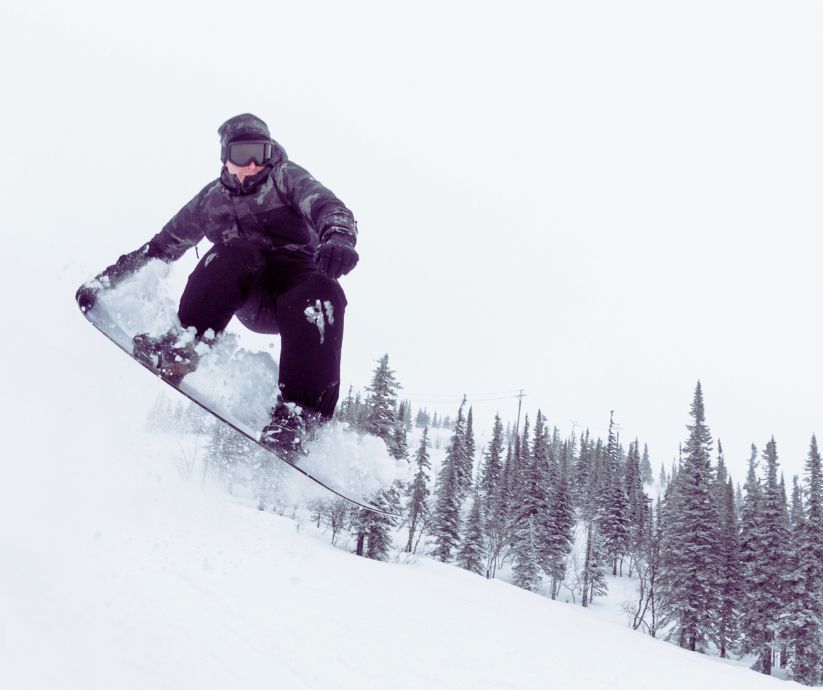
As I look out my window today, the tops of the mountains are now capped with snow. Every year, the excitement of returning to the slopes (that we have in abundance within minutes of our homes) returns to me. I cannot wait to get out there.
I also remember my second time skiing as a 14-year-old. I was given used, well, everything and on this old untested equipment, I ‘Klammered’* down Morin Heights, Quebec, Bellevue (elevation 656 feet!) with youthful abandon.
Result: Dislocated shoulder that I live with to this day…
My bindings did not release. As I fell, a whirlwind of unreleased skis and four limbs helicoptered in every conceivable rotational direction. I’m surprised I didn’t just lift off and rise above the earth. But no, gravity was the winner. A whole season of skiing was lost, and a lifetime of recurrent shoulder discomfort resulted. Even when I moved West and discovered ski mountains (replacing the ski hills of Quebec), the pleasure of skiing was somewhat restrained by the caution of this memory.
Skiing has been joined by its younger sibling, snowboarding. Whatever your delight, I. HIGHLY. RECOMMEND. PREPARATION. This doesn’t only mean having your equipment tested for safety before you first go out. It isn’t the only equipment you need to test and prepare.
Dr Olson and I discussed this subject just yesterday. To PREVENT injuries that cause you low back, neck, and shoulder pain, we believe that you need to PREPARE your body.
A misaligned pelvis (the cause of 8 of 10 low back pain cases at this clinic), weakens knee strength more so than any other factor. We’ll explain why and how. A twisted pelvis (Sacroiliac joints) will also rotate the hips, knees and ankles affecting their stability by having each lower limb’s muscles pull differently. This twisting of the pelvis throws the upper body out of balance too.
Dr Olson believes that hip and ankle stability and knee strength are key to proper function in injury prevention.
As you would before a long vehicle road trip, have the machine that is taking you down hills at speed checked out. Get us to assess you BEFORE your season starts. We are experienced in assessing each muscle, and each joint for its strength and stability. If you have hard falls (most people land on their bottoms or shoulders), we recommend the same.
Here are targeted exercises and considerations to prepare your ankles, knees, and hips specifically, reducing the risk of skiing and snowboarding injuries:
Ankle Exercises
- Ankle Mobility Exercises: Perform ankle circles, alphabet writing with your toes, and resistance band exercises to improve flexibility and strength around the ankle joint.
- Balance Training: Use a wobbleboard or balance disc to enhance ankle stability, mimicking the uneven terrain of skiing.
- Calf Raises: Strengthen the calves to support ankle movements during skiing. Perform single-leg calf raises to enhance balance and strength.
Knee Exercises
- Quadriceps Strengthening: Exercises like squats, lunges, and leg presses bolster the quadriceps, providing stability to the knee joint.
- Hamstring Exercises: Strengthen hamstrings with deadlifts, hamstring curls, and bridges to balance the muscle strength around the knee.
- Lateral Movements: Incorporate lateral lunges and side step-ups to improve lateral stability, crucial for skiing maneuvers.
- Balance and Proprioception: Utilize balance exercises to improve knee joint stability and proprioception, reducing the risk of ligament strains.
Hip Exercises
- Hip Abductor and Adductor Strengthening: Exercises like side leg lifts and clamshells target these muscles, enhancing stability for lateral movements.
- Squats and Bridges: Strengthen the glutes and hips with squats and bridges, aiding in overall stability and power during skiing.
- Rotational Exercises: Engage in exercises that involve rotational movements to improve hip mobility and readiness for turning on the slopes.
Additional Considerations
- Proper Alignment: Ensure proper alignment of your lower body during exercises to prevent unnecessary stress on joints (what I discussed above).
- Gradual Progression: Increase intensity and difficulty gradually to allow your joints to adapt and strengthen progressively.
- Good Footwear: Invest in proper skiing boots that provide ankle support and stability.
- Consistency in performing these exercises, along with a focus on maintaining proper form and alignment, will significantly reduce the risk of injuries to your ankles, knees, and hips.
For a PDF handout of exercises, ask us for our Ski Snowboard Injury Prevention Handout.
*(reference Franz Klammer, winner of the 1976 Innsbruck Winter Olympics Downhill. See YouTube ‘Greatest Downhill Run of All Time ‘, still gives me goosebumps)
Dr. Christopher Walker
Contact Me

